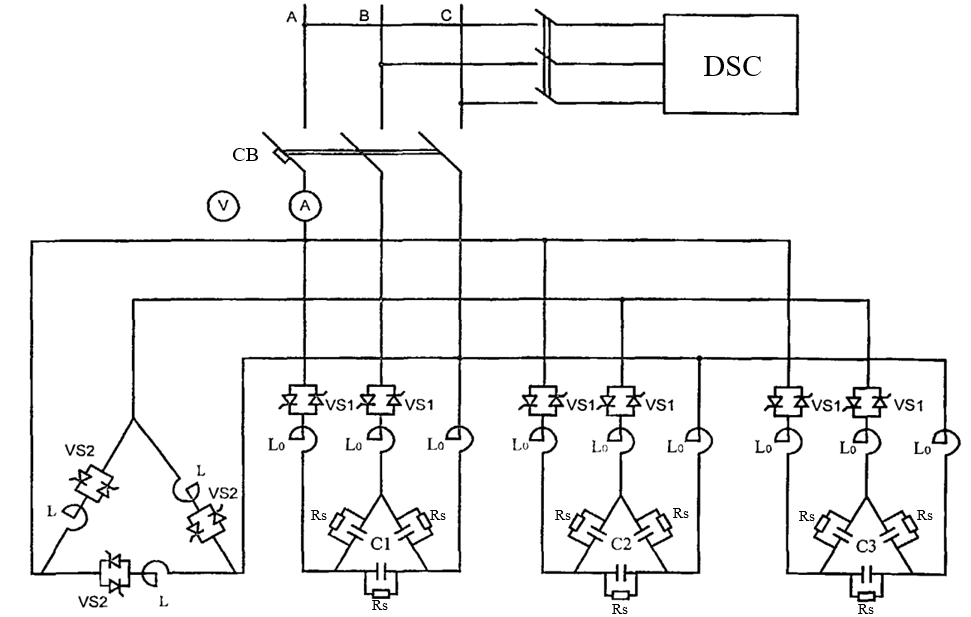Дата публикации: 20.03.2022
Bobuyok Sergey Andreevich
Akhmetov Adil Erlanovich
Vedyashkin Vladimir Evgenievich
master students,
Karaganda Technical University,
Kazakhstan, Karaganda
ABSTRACT
Rural power grids of 0.4 kV have unstable characteristics. The length of the line varies from 250 to 900 m, power - from 8 to 32 kW, wire cross-section - from 16 to 70 mm2, distributed over a large area. They have sharply uneven load schedules in time and in phases. All this increases energy losses in the networks. Technical losses in them amount to 20...25% of the useful energy consumption [1]. At the same time, half of them are due to the consumption of reactive energy from the grid, that is, a low power factor. The use of ordinary unregulated systems for the correction of the power factor in enterprises of the type under consideration is extremely inefficient due to sharply alternating loads. In addition, in such conditions, the phenomena of under- and overcompensation are possible, which can only accelerate the wear of reactive power consumers in production. The use of automatic reactive power compensation units (ARPCU) makes it possible to solve the problem of a low power factor much more efficiently.
Keywords: reactive power compensation, power factor, agriculture, thyristor compensators
Analysis of consumers of reactive power of agricultural enterprises
The appearance of the term "reactive" power is associated with the need to allocate the power consumed by the load, the component that forms electromagnetic fields and provides the torque of the engine. This component takes place with the inductive nature of the load. For example, when connecting electric motors. Practically the entire household load, not to mention industrial production, is inductive in nature. In electrical circuits, when the load has an active (resistive) character, the flowing current is in-phase (does not advance and does not lag) from tension. If the load is inductive (motors, transformers at idle), the current lags behind the voltage. When the load has a capacitive character (capacitors), the current outstrips the voltage.
Agricultural enterprises occupy leading positions in terms of nomenclature, quantity, and installed capacity of electrical installations among other industries. For example, the nomenclature of electrical equipment alone is over 300 items, electric motors have about 200 standard sizes, electric heaters - about 40, lamps - more than 50. It is extremely difficult to disassemble each of these types of electrical installations separately and does not have much practical use, therefore, Table 1 summarizes several parameters for electrical equipment as a whole so that it is possible to approximate their place in the power system of an agricultural enterprise [2,3].
It can be understood that electric drives occupy the first place in all indicators (except for the nomenclature, the diversity of which is expected for lighting installations). This is a massive and energy-intensive equipment in agriculture.
Table 1. The main parameters of the electric equipment fleet of agricultural enterprises
|
Type of electrical equipment
|
|
Specific weight, %
|
|
|
|
Number
|
Installed
power
|
Energy
consumption
|
||
|
Electric drives
|
19
|
70
|
64
|
|
|
Electric heating units
|
2
|
20
|
24
|
|
|
Electric lighting systems
|
77
|
6
|
8
|
|
|
Other
|
2
|
4
|
3
|
|
|
|
|
|
|
|
Application of a thyristor reactive power compensator
Based on the analysis of known reactive power sources [4-7], a scheme of a regulated reactive power source is selected, shown in Figure 1.

Figure 1. Schematic diagram of a thyristor reactive power compensator
It has high speed, high efficiency coefficient, low content of higher current harmonics. The circuit contains capacitor banks and regulated reactors (inductors). It is advisable to use such sources for centralized voltage regulation, i.e. to install them on low-voltage substation buses. The main elements of the scheme:
L - regulated reactors;
Lo - current-limiting reactors;
VS - thyristor switches;
C1=C2=C3 - capacitor banks;
RS - shunt resistors;
CB - circuit breaker;
DCS - digital control system.
The use of thyristor switches for switching capacitors in compensating devices provides the necessary performance. In addition, with the help of thyristor switches, it is possible to limit or even eliminate overvoltages on capacitors and improve transients in capacitances when they are switched on and off.
To ensure reliable operation of the VS1 key thyristors, it is necessary to limit the rate of current rise through them di/dt. In other words, to reduce the influence of the load current on the shape of the output voltage curve, current limiting Lo reactors are connected.
The VS1 thyristor switches are located only in two phases, which reduces the power loss in the capacitor bank switching device by one third, since such a device has large energy losses and is a source of higher harmonics. Thyristor switches are used to turn on capacitors, control pulses are fed to the valves during each half-cycle, automatically turning on the capacitor at the moment when the voltage at the terminals of the capacitor is equal to the mains voltage
The second feature of the scheme is that the L source reactors with series connected VS2 thyristor regulators are connected according to the triangle scheme.
The power of three reactors L is equal to the power of one stage of the capacitor bank. The protective element of the entire source is an automatic switch. To ensure the discharge of the capacitance of the capacitors, shunt resistors Rs are provided. The central control system of the DCS receives power from the same three-phase network through a separate switch CB.
Conclusion
Thyristor capacitor installations are the best solution when it is necessary to compensate for the reactive power of the load in a short period of time. The main element of the considered device, ensuring the fulfillment of its functional tasks, is an automatic control system. Condenser installations with thyristor switches are used in enterprises with a sharply variable load, which can reasonably be attributed to agricultural enterprises.
The advantages of the presented installation include: reducing losses in the power supply system, increasing the available capacity of the enterprise, lower voltage drops on the elements of the power supply system, minimizing anomalies in the power grid such as flicker and voltage drop, no moving parts, increasing the service life of capacitors by at least 1.5 times [8].
References:
-
Gordeev, A. S. Energy saving in agriculture. Textbook/ A.S. Gordeev, D.D. Ogorodnikov, I.V. Yudaev. - M.: Lan, 2014. - 400 p.
-
Static thyristor reactive power compensator [Electronic resource]. - URL: https://elenergi.ru/staticheskij-tiristornyj-kompensator-reaktivnoj-moshhnosti.html (accessed 13.02.2022).
-
Sibikin, Yu.D. Power supply of oil and gas production and processing enterprises: Textbook / Yu.D. Sibikin. - M.: Forum, 2018. - 416 p.
-
Kabyshev A.V. Reactive power compensation in electrical installations of industrial enterprises: textbook. - Moscow: Publishing House of Tomsk Polytechnic University, 2012. - 234 p.
-
Shcherbakov, E.F. Power supply and power consumption in agriculture: Textbook / E.F. Shcherbakov, D.S. Alexandrov, A.L. Dubov. - St. Petersburg: Lan, 2018. - 392 p.
-
Korobov, G.V. Power supply. Course design / G.V. Korobov. - St. Petersburg: Lan, 2014. - 192 p.
-
Yanukovych, G.I. Power supply of agriculture: Practicum / G.I. Yanukovych, I.V. Protosovitsky, A.I. Zelenkevich. - M.: Infra-M, 2018. - 304 p.
-
Nikitenko, G.V. Electrical equipment, electrical technologies and power supply of agriculture. Diploma design: Textbook / G.V. Nikitenko, E.V. Konoplev. - St. Petersburg: Lan, 2018. - 316 p.
